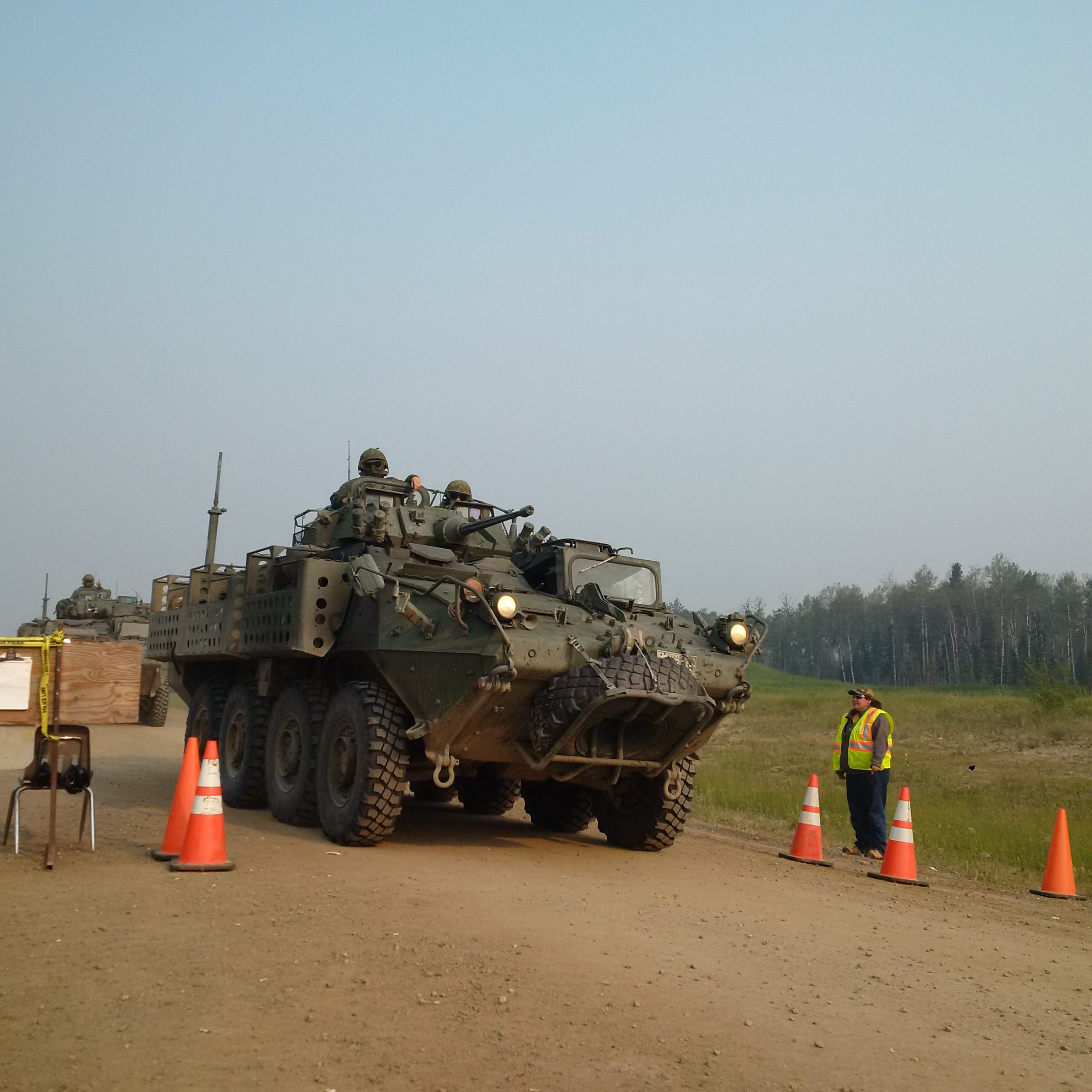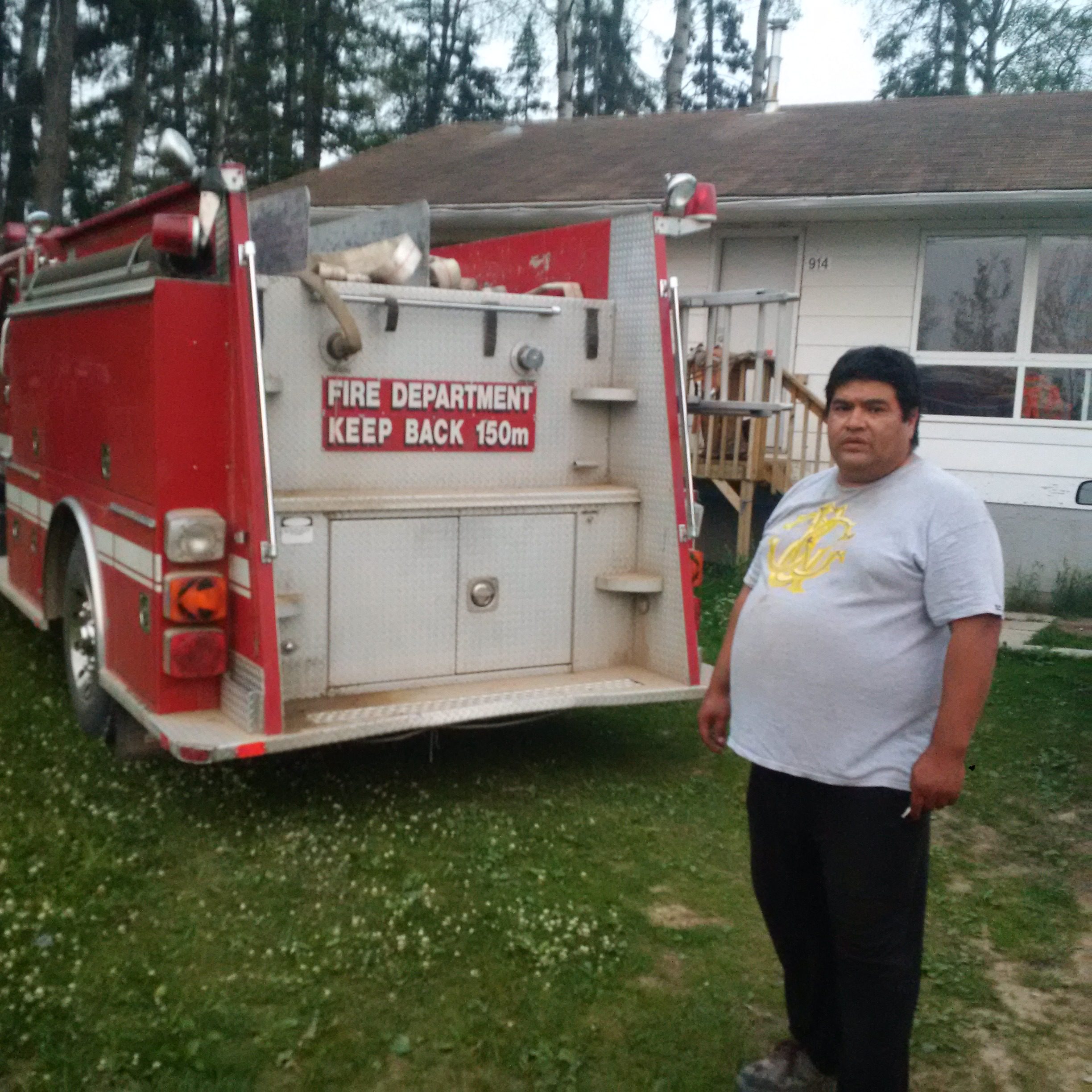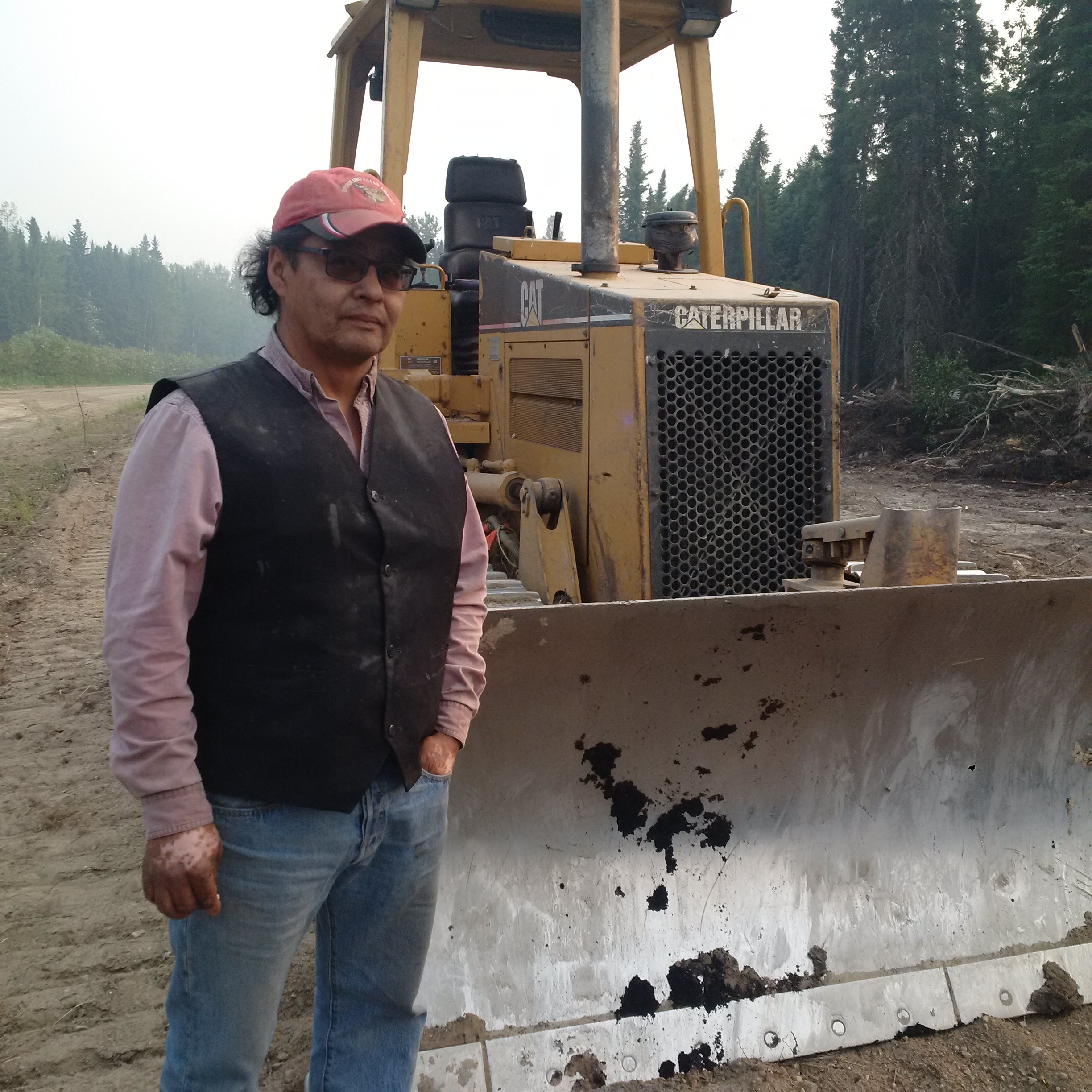(The remains of a four-plex in Montreal Lake obliterated by fire. APTN/photo)
Jorge Barrera
APTN National News
MONTREAL LAKE CREE NATION, Sask.–Montreal Lake Cree Nation Chief Edward Henderson gazes across the obliterated remains of the building, once a four-plex, now nothing but ash, twisted tin and metal strewn in what was once the foundation which now resembles a crater.
The wildfire wiped out five other buildings, all homes, in the community in the same way.
The flames completely consumed the structure, leaving nothing but ashen dust and the warped and blackened shapes of stoves and washing machines.
While the losses weigh heavily on Henderson, he knows it could have been much worse. A shift in wind, a twist of fate, saved the community from being completely destroyed on July 3 when a “beast” of a wildfire roared through the reserve.
“It is hard to explain,” said Henderson, as he toured the community Friday evening. “It could be because of the wind change that saved some of these houses.”
Henderson said the four-plex was destroyed by an “acorn,” a flaming missile launched by the approaching wildfire that can travel over two kilometres beyond the main wall of the flames.
“It’s like throwing matches ahead of you, about a mile ahead of you,” said Henderson.
The four-plex stood between two houses and the heat of the fire melted the siding on both like wax.

Just off another road in the community along a wooded stretch lies the ashen remains of another home. A wooden deck chair somehow survived and it is surrounded by trees that now resemble a forest of charred wooden matchsticks.
Throughout the community the tracks of the flames, some still smouldering, reveal how close it all came to complete devastation. Sometimes the fire swept to the threshold of a backdoor, or surrounded a lot, but never consumed the home.
In one instance, the wildfire burned the shed and car in the backyard of a home, but suddenly swept in another direction before touching the main structure. That home stood on a road lined with houses that was about to be consumed by a “wall of fire” that changed course with no explanation, said Henderson.
“I thought for sure we were going to lose this street in this subdivision,” he said.

The wildfire hit with full force at about 6 p.m. that Friday, knocking out the power, said Henderson.
Barry Roberts, 21, did not leave with the evacuation triggered the week before and was in his brother’s house when he saw the flames across the street that day.
“We couldn’t grab nothing, we looked out the window and seen those flames and ran out of the house. We didn’t even have time to lock the door,” said Roberts, who was evacuated to Prince Albert, Sask., which sits about 100 kilometres south of Montreal Lake.
His brother’s house survived.
Leona Bird, 44, wasn’t so lucky. After living in her mother’s basement with her four children for seven months she finally moved into her new home five months ago. Now, it’s destroyed. She found out flames consumed her home on Facebook after someone posted photos of the fire.
“I didn’t believe it was burning,” she said.
Bird said her biggest losses are her children’s baby photographs and photographs of family members her mother gave her for safe keeping.
“Sometimes I get emotional thinking about it because you can’t replace those things,” said Bird, who was also evacuated to Prince Albert.
RCMP Sgt. Al Presler vividly remembers that Friday.
“We were surrounded by fire. There was fire from the south and then from the west. You look behind you and it’s barreling over the road. You initially feel trapped,” said Presler, who is the detachment commander for the area.
Presler managed to capture on his cell phone the desperate air war launched that day to save the community. In one video you can see two water bombers, the type that skid over lakes to pick up water, piercing the smoke and delivering their payload.
“This beast is coming through and you are running for your life… It’s scary,” said Presler. “It’s something you can’t even explain.”
The battle for Montreal Lake continues.
A convoy of Canadian Forces personnel riding LAV’s with gun muzzles covered arrive every day at 8 p.m. as part of Operation LENTUS to beat back the flames still threatening the community. There are about 150 military personnel in the Montreal Lake area currently engaged in the task, according to spokesperson Capt. Brian Kominar.


Through the air, helicopters make regular runs to drop their water payloads just beyond the main community where the fire continues to flare.
Henderson said there are also about 150 firefighters and nine firetrucks in the area continuing to protect Montreal Lake from a repeat of July 3.
Most of the firetrucks were sent by First Nation communities in response to a call-out from Henderson. Muskeg Lake Cree Nation Fire Chief Jason Ledoux was one those who answered Henderson’s call and he brought his community’s firetruck and a crew of six to bolster the front lines.
“I really wanted to come and do this,” said Ledoux, who is related to people in Montreal Lake and sings for music group, In Disguise, with a member of the community. “That is part of our heritage to help each other and make sure we are okay.”
Ledoux said the battle against the wildfire is grueling as his crew often finds itself up to 1,000 yards deep into the forest with their hoses trailing back to the truck.
“We have been putting down hotspots. We have been knocking it literally out of the trees,” he said. “Yesterday we saved a house, there was quite a flare-up and if we didn’t knock it out of the trees it would have burnt the house down.”
Then, there’s the horseflies he calls “bulldogs” that constantly swarm his crew.
“There’s lots of bulldog action… they bite hard and they swarm the trucks and they are attracted to the heat and the water. They are all around you steady,” he said.
There’s also an ever present danger, not only from the fire, but from the trees weakened by the flames.
One of his crew members recently had a close call, he said.
“We had a tree come down,” said Ledoux. “He only had a few seconds to get out of the way and it ripped the hose out of his hands when it came down.”
Ledoux said Saskatchewan’s wildfire fighting regulations only let his crew battle flames between 7 a.m. and 7 p.m. Night firefighting is not allowed and that’s a mistake, he said.
“The last three hours of the day are more productive than the first eight hours,” he said. “The fire is laying back, it’s cooler, the bugs are down and there’s less heat.”


Montreal Lake member Lionel Bird agrees. For the past 12 days Bird has been operating a bulldozer in the Montreal Lake area trying to build firewalls to surround the fire. Bird is a veteran of the forest fire wars and he remembers crews engaging the flames through shifts covering 24 hours.
“In the old days crews would go all night long. They were able to see hot spots and they were able to put them out when the wind is less and it’s colder…the guys could go hard,” said Bird. “During the day, with 25 to 30 degree temperatures with a lot of wind makes firefighting that much harder and that much more dangerous.”
Bird said Saskatchewan’s decision to forbid night firefighting was made by a bureaucracy with no idea about front line battles.
“I believe it was somebody behind a desk that decided this was the best approach. It’s somebody that never walked a line, never fought a fire, but had all the training. That’s how decisions are made,” said Bird.
Henderson believes this type of bureaucratic thinking by Saskatchewan officials nearly cost his whole community after lighting struck sometime around June 25 triggering the fire that nearly wiped out Montreal Lake.
Henderson said community members wanted to attack the flames when the fire grew to about 10 hectares, but provincial officials refused to provide any help or allow volunteers to engage the flames without proper certification.
“Our people have been fighting fires for years without certification. They know the conditions. It would have been a totally different story if we were allowed to challenge that 10 hectare fire in our community,” he said.
The fire has since grown to 4,000 hectares, said Henderson.
Saskatchewan officials only swung into action when Montreal Lake was in dire threat, said Henderson. Provincial officials gave the community only 2 hours to evacuate about 900 people, he said.
“That is the frustrating part over the last couple of weeks. We were being told over and over again there is no threat to your community,” he said. “We are watching people standing by wanting to fight the fire, but told ‘you have to be certified.’”
While the Canadian Forces are focusing their Saskatchewan efforts in the Montreal Lake area and farther north in La Ronge, Saskatchewan Premier Brad Wall has all but ignored the plight of the Cree nation, said Henderson.
Henderson said he has never received a call from the premier who has passed through the area on the way to La Ronge, which has a population of 2,700 and sits about 380 kilometres northeast of Saskatoon. La Ronge sits next to the Lac La Ronge Indian Band, which has a population of about 10,000 people. Both communities have been evacuated and face serious threat from a massive wildfire on its borders.
The area’s local Conservative MP Rob Clarke has also failed to contact Henderson to find out how the community is doing.
“Not even a courtesy call,” said Henderson.
Henderson did receive a call from the provincial environment minister Friday.
Back in Prince Albert where many Montreal Lake residents are staying, there was talk that they could return home as early as Tuesday.
Henderson said that appears unlikely now and it could be at least a week before people can come home.
@JorgeBarrera










I fully agree with Montreal Lake Cree Nation Chief Edward Henderson, i too remember experiencing the days we used to fight fire at night until this was stopped by some idiotic bureaucrat that knew nothing of front line fire fighting, likely the only fire fighting he knew about was what he learned in a classroom at some university, I once met a resource officer that came to talk to us at a fire on the Beaver river south of Beauval and he said that we were safe where we were, I could tell from there he just come out of university. The beaver river might just as well be a creek, with a strong wind acorns popping from the heat can fly a mile or more, because I’ve seen them, the Beaver river is only maybe a hundred yards at the widest and another thing these jokers before going out in the bush always carry compasses we on the other don’t need a compasses to walk around in the bush, because we know our bearings by studying the lay of the land, we are after all part of the land, we make our living off the land, I wonder what these jokers would do if one day they tripped and broke their compasses, they’d be completely lost. I never carry a compass I’m still here and I spend a lot of time out in the bush. i once asked a resource officer 3what it is that night fire fighting is not allowed any longer and he told me that it had to do with Compensation, too many men would lose their eyes from walking into snags, i just about busted out laughing and I asked him how many Northerners did you see walking around blind of course he had no answer to that question, I’ve walked around in the bush lots even at night, i’ve never walked into snags a person would have to be completely blind to walk into anything at night, aperson used to the bush can clearly see even at night. So There any arguments.